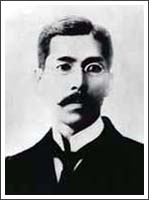- Takayama Chogyū
Infobox Writer
name = Takayama Chogyū

caption = Takayama Chogyū
birthdate = birth date|1871|2|28|df=y
birthplace =Tsuruoka, Yamagata ,Japan
deathdate = death date and age|1902|12|24|1871|2|28|df=y
deathplace =Chigasaki, Kanagawa ,Japan
occupation = Writer
genre = novels, art history, Buddhist philosophy
movement =
notableworks =
influences =
influenced = nihongo|Takayama Chogyū|高山樗牛|Takayama Chogyū|extra=28 February 1871 –24 December 1902 , real name Takayama Rinjiro, was aJapanese author and literary critic. He profoundly influencedJapanese literature in the lateMeiji period with his blend of romantic individualism, concepts ofself-realization ,aesthetics , andnationalism . However, many of Chogyū's works seems cryptic to contemporary readers due to the archaic style which he employed.Early life
Chogyū was born in
Tsuruoka city inYamagata Prefecture . His father was a minor "samurai " of the Shonai domain, who found employment with the police after theMeiji Restoration . At the age of two he was adopted by his aunt's family.In 1887 he entered high school in Sendai, where he excelled in
English language andEnglish literature . While studying philosophy atTokyo Imperial University , he was influenced byThomas Greene 's concepts of self-realization and nationalism.Literary career
Chogyū entered and won a fiction contest sponsored by
Yomiuri Shimbun newspaper for his semi-historical romance, "Takiguchi Nyudo". While still a student, he co-founded theliterary journal "Teikoku Bungaku " ("Imperial Literature") and submitted articles to the literary magazine, "Taiyō" ("Sun"), of which he later became senior editor. He also changed his official residence toHokkaidō to avoidmilitary conscription .In 1896, Chogyū returned to Sendai to teach English and logic at a prestigious high school. A student revolt the following year forced him give up teaching to edit a literary magazine, and he returned Tokyo. It was at this time he married Sato Sugi.
During the surge of
ultra-nationalism that enveloped Japan in the wake of theFirst Sino-Japanese War of 1895. Chogyū wrote about his identity as a Japanese. He regardednationalism as laudable in some respects, but also recognized a need to cooperate internationally. Although patriotic, Chogyū later expressed concern with the militaristic tendencies developing in Japan.In 1900, Ministry of Education selected Chogyū to study in Europe together with
Natsume Sōseki , but he developedtuberculosis and declined. During his convalescence, he wrote articles praisingFriedrich Nietzsche and onaesthetics . In 1901, Chogyū became a professor atToyo University . Teaching one day a week, he devoted most of his time to writing. In 1902, he received a doctorate in literature from Tokyo Imperial University, writing aboutAsuka period art. The work left him exhausted.As sea air was thought to be helpful for lung ailments, Chogyū moved from Tokyo to the seaside resort towns of Atami, Shimizu, Oiso, and finally to Kamakura in an effort to cure his disease. With the likelihood of recovery increasingly remote, he turned his attention the teachings of 13th century Buddhist leader,
Nichiren . He continued to write, but on religious philosophy, especially Nichirenism. Unfortunately, his condition worsened and he died on24 December 1902 at a hospital in nearby Chigasaki. He lived in a house within the precincts of Kamakura's Hase-dera during the last year of his life, and his funeral rites were at the temple.However, his grave is located at Ryuge-ji, a temple in
Shimizu ,Shizuoka Prefecture . The inscription on the grave is from one of his writings: “Obviously we should transcend the present”.Although Chogyū's literary career spanned a mere six years, he had a major impact on other Japanese writers and it is a pity he is unknown outside of Japan.
External links
* [http://www.aozora.gr.jp/index_pages/person271.html e-texts of works at
Aozora Bunko (Japanese site)]
* [http://www.ryugeji.jp/bungou.html Chogyu’s monumental grave at Ryuge-ji (Japanese site)]
* [http://www.city.kamakura.kanagawa.jp/english/bunjin/takayama_e.htm Literary Figures from Kamakura]References
* Gluck, Carol. "Japan's Modern Myths". Princeton University Press (1987). ISBN 0691008124
* Suzuki, Tomi. "Narrating the Self: Fictions of Japanese Modernity". Stanford University Press (1997). ISBN 0804731624.
Wikimedia Foundation. 2010.
